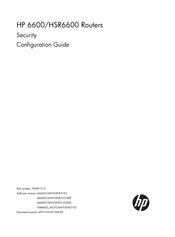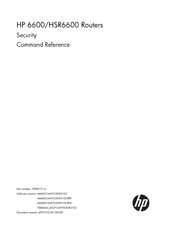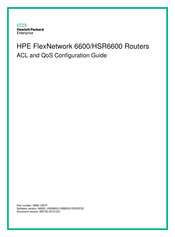HP FlexNetwork HSR6600 WAN Router Manuals
Manuals and User Guides for HP FlexNetwork HSR6600 WAN Router. We have 7 HP FlexNetwork HSR6600 WAN Router manuals available for free PDF download: Configuration Manual, Security Configuration Manual, Command Reference Manual, Troubleshooting Manual
HP FlexNetwork HSR6600 Security Configuration Manual (559 pages)
Brand: HP
|
Category: Network Router
|
Size: 8.59 MB
Table of Contents
-
-
Overview21
-
-
-
-
Enabling 802.1X102
-
-
Overview120
-
Free IP120
-
URL Redirection120
-
-
-
-
Overview127
-
-
VLAN Assignment128
-
ACL Assignment128
-
-
-
-
Overview137
-
-
-
-
Overview192
-
-
-
Overview216
-
FIPS Compliance218
-
Advertisement
HP FlexNetwork HSR6600 Command Reference Manual (542 pages)
Brand: HP
|
Category: Network Router
|
Size: 2.41 MB
Table of Contents
-
-
-
-
Access-Limit54
-
Group63
-
Local-User64
-
Password65
-
Service-Type67
-
User-Group68
-
-
-
Radius Trap93
-
Retry95
-
Server-Type103
-
State Primary104
-
State Secondary104
-
-
Display Hwtacacs111
-
Hwtacacs Scheme114
-
Hwtacacs Nas-Ip116
-
Hwtacacs Scheme117
-
-
802.1X Commands133
-
Display Dot1X133
-
Dot1X137
-
Dot1X Guest-Vlan143
-
Dot1X Handshake144
-
Dot1X Max-User146
-
Dot1X Retry152
-
Dot1X Timer154
-
-
-
Dot1X Free-Ip158
-
Dot1X Url159
-
-
-
Portal Domain188
-
Portal Free-Rule189
-
Portal Max-User190
-
Portal Nas-ID191
-
Portal Nas-Ip193
-
Portal Server195
-
-
-
User-Profile224
HP FlexNetwork HSR6600 Configuration Manual (614 pages)
Comware 7 MPLS
Brand: HP
|
Category: Network Router
|
Size: 6.69 MB
Table of Contents
-
Protocols35
-
Enabling LDP36
-
CRLSP Backup87
-
Configuring RSVP181
Advertisement
HP FlexNetwork HSR6600 Command Reference Manual (286 pages)
Brand: HP
|
Category: Network Router
|
Size: 1.33 MB
Table of Contents
-
-
-
Bandwidth10
-
Combo Enable10
-
Default11
-
Description12
-
Duplex29
-
Flag Sdh29
-
Interface31
-
Link-Delay32
-
Loopback32
-
Port-Mode35
-
Shutdown37
-
Speed38
-
-
-
Group-Member45
-
MDI51
-
Speed Auto54
-
-
Mtu60
-
Promiscuous62
-
-
-
-
-
Bandwidth63
-
Default63
-
Description64
-
Shutdown69
-
-
-
-
Clock74
-
Frame-Format75
-
Loopback76
-
Scramble76
-
-
HP FlexNetwork HSR6600 Configuration Manual (236 pages)
Brand: HP
|
Category: Network Router
|
Size: 2.62 MB
Table of Contents
HP FlexNetwork HSR6600 Configuration Manual (180 pages)
ACL and QoS
Brand: HP
|
Category: Network Router
|
Size: 2.19 MB
Table of Contents
-
-
Overview8
-
-
Qos Overview
22 -
-
Overview32
-
-
-
Overview38
-
-
-
Overview49
-
-
HP FlexNetwork HSR6600 Troubleshooting Manual (41 pages)
Brand: HP
|
Category: Network Router
|
Size: 0.36 MB
Table of Contents
-
-
Packet Loss15
-
-
-
IRF Split23
Advertisement






